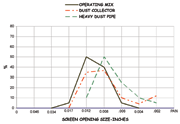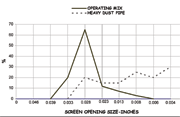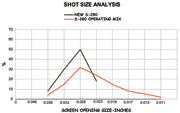E-Archive
Articles
in Vol. 9 - November Issue - Year 2008
Effective Use Of Abrasive Blast Cleaning


Figure 1 shows why different sizes of shot are required to cover the entire area

Figure 2 shows considerable wastage of abrasive via the separator and the dust arrestor. The result of this will have a serious effect upon the machine.

Figure 3 shows poor abrasive control. Delay in making new additions results in an operating mix, which is coarse and will affect both machine output and surface finish of the work pieces.

Figure 4 shows particle screen size ranges
Dust collectors and separators play a very important role in the life of wear parts. Another crucial issue is the abrasive media. However it is one of the most neglected areas and is a major area of concern. The following are the findings of the author:
-No regular interval specified for addition of abrasives. Abrasives added when the blasting time increases the specified time limit.
-Sizes of abrasives changed on the availability & cost
-No incoming abrasive inspection for quality
-No records maintained
The above factors play a very vital role in the blast cleaning process. The effect of abrasive size can be understood very clearly from figure 1.
From the above it will be understood that to throw 500 gram of S780 is vastly different from throwing 500 gram of S70 shot. The impact of larger shot will be concentrated over a much smaller area than that of the finer abrasive. Neither would prove to be an efficient blast media. The larger abrasive would probably remove all the contaminants but over too small an area to be economical. The finer shot, assuming it to be thrown over a proportionately larger area, may not have the necessary impact value per particle to remove the surface condition. Hence the reason for a combination mixture, where the large particles are to carry out the major work of loosening the contaminants whilst the smaller particles carry out the lighter removal and provide coverage.
It's balanced operating mix that does the work
A balanced work mix size distribution produces a better, more uniform surface profile, best suited for subsequent operations such as machining, bonding or painting etc. Effective and economical abrasive mixes contain a size range from small, medium to large particles. The choice of an abrasive for a particulate application is that of finish. The finishing operation may be the removal of heavy scale from a steel billet or the very light removal of sand from manhole cover castings. There are the surface preparations for critical applications of coatings of many types. All these demand individual choice of abrasives.
It will be appreciated that the cleaning rate varies with the choice of abrasive and the type of material being treated. The particular abrasive selected will also affect maintenance costs. From this it will be seen that the criteria of choice is that of desired surface finish.
Thus it is evident that a properly balanced size distribution in the abrasive work mix is the key to effective and efficient blast cleaning. Thus it is necessary to carry out the screen analysis of the operating mix.
To maintain the proper operating mix the separator has to work efficiently hence the need for screen analysis of the operating mix & abrasive contained in the separator discard is equally obvious.
The objectives of the screen analysis are:
To determine whether the abrasive operating mix is in proper balance for effective cleaning.
To determine whether harmful contaminants are being removed from the work mix.
To determine whether usable abrasive is being wasted because of improper separation.
This practice of monitoring and controlling of abrasive mix is not being carried out and the outcome is:
• Cleaning costs can escalate – go completely out of sight.
• Quality of finish – the very reason for blast cleaning – can deteriorate rapidly and make for unhappy customers.
• Productivity in the concerned department can fall off severely and bottleneck the flow of finished product. Incorrect method of making additions results in an operating mix that is too coarse and one which will reduce the rate of cleaning and produce a rough finish. This is due to the interval between the additions of new abrasive being too long. Curve 2 in the same graph shows the effect of an incorrectly set separator. Erratic methods of adding abrasive can have the reverse effect of the previous case. The condition is one formed when the addition of new abrasive has been delayed and before topping up. Again the effectiveness of the blast will be diminished and the surface finish considerably lightened in texture. The heavy dust pipeline indicates an incorrect setting of the separator and that very little dust is taken into the dust arrestor. A very poor operating mix will give a rough finish at low output. The consumption of abrasives will be high with heavy wear and tear on the ducting and dust tubes.
Generally the operating mix should contain no more than 40% or no less than 20% particles of sizes equivalent to or larger than the newly purchased (nominal screen) size. The operating mix should typically contain particles of sizes ranging from one screen size larger to four or more screen sizes smaller than the nominal screen size of the new abrasive.
Contaminants in the operating mix:
The function of a good separator is to separate contaminants such as sand, ceramics, oxides, scale etc. Fines of this nature if present in the operating mix impose tremendous wear on the blast wheel components, causing high maintenance/replacement costs, causing costly break down time. One has to bear in mind that if retained fine is around 2% by weight in the operating mix then it can cut the normal life of wheel components by half or more.
Thus, the objective of screening samples of operating mix is to check the size distribution of abrasives and if any contaminants are present in the operating mix.
If after screening, the residue or fine collected in the pan contains unusable abrasive & contaminant detrimental to the system then separate the contaminants from unusable abrasive using magnetic separation and in case it becomes difficult to separate then it is best to use screen size of 0.007" and screen the same and calculate the percentage by weight.
Hence, it is advisable that all users of blast cleaning equipment should carry out all screen analysis of abrasives from time to time and should form a part of Process Control. It should be done biweekly and proper control should be there in abrasive replenishment.
One more important factor is to control the abrasive size of new abrasive. The following has been observed:
1. Size mentioned on the bag could be as specified by the purchaser but the user finds it unsuitable visually and since no in house facility is available it is accepted causing production to be held up.
2. Abrasives are rusted thus increasing the percentage of contaminants in the system more than it is desired and the production has to run the machine idle for sometime to get rid of the contaminants.
3. The user rarely checks the chemical properties.
In order to contain all this proper process control has to be developed in all organizations using blast cleaning systems.
Reference
1. Blast Cleaning & Allied Process by H. J. Plaster.
2. Guidelines for Centrifugal Blast Cleaning by A. W. Mallory
MFN Office India
For information:
Tel. +91.22 26865391-93
Mob. +91.9820326163
E-mail: ananda@mfn.li



























